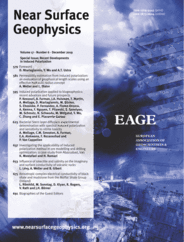
Full text loading...
The main issue in mineral exploration is to obtain as much information as possible in a time‐ and cost‐efficient manner. This may be achieved through a combination of geophysical methods including the induced polarization method. The induced polarization is the most applicable method in case of metal exploration through drilling. We argue that the relationship between induced polarization, electrical resistivity and ore grade data may be used in resource estimation. This argument is tested in the active copper mine of Madan Bozorg, Abassabad, which is located in the Miami‐Sabzevar mineralization belt in NW Iran. Within the borehole locations, geophysical profiles of induced polarization and electrical resistivity were designed and surveyed using combined resistivity sounding and profiling array. Two‐dimensional models of induced polarization and electrical resistivity were prepared through inversion of geophysical data, after the primary processing. The three‐dimensional block models of induced polarization and electrical resistivity were also compiled using geostatistical methods. Obtained two‐dimensional and three‐dimensional models of induced polarization and electrical resistivity were checked using exploratory boreholes to investigate the relationship among induced polarization, electrical resistivity and copper grade. The three‐dimensional block model of the copper ore was prepared using cokriging and artificial neural network, using a combination of induced polarization and drilling data. In the cases where borehole data were unavailable, the presence of copper ore was predicted by artificial neural network and cokriging methods, and the three‐dimensional models of ore body were constructed in all of the study area. Obtained models based on the predicted copper ore distribution were checked and compared with ore distribution model compiled using drilling data. The results indicate a good agreement between predicted and real results. This led to reduction of borehole number to about 45% and the optimization of boreholes locations. Finally, an optimized drilling plan has been prepared and presented for the Abassabad copper mine.

Article metrics loading...

Full text loading...
References


Data & Media loading...

